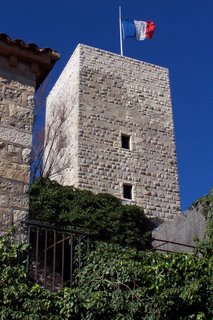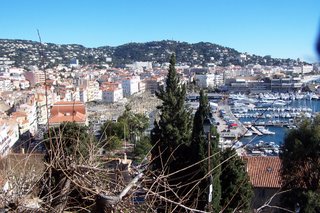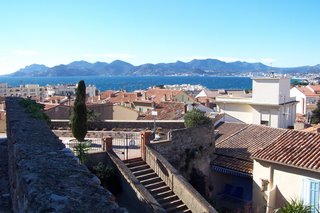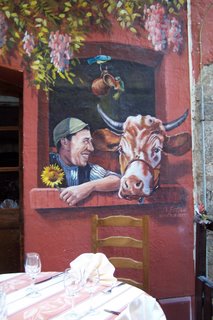13 February 2007Ah Cannes , beautiful Cannes. Small enough to be absorbed by a visitor, large enough to generate a powerful pulse. While a lady down the coast told us that every time she went to Cannes it rained, and every time she had to buy an umbrella ending up with 20 of them, we had the benefit of a crystal clear day, sunny and windy in the morning and sunny and warm in the afternoon.
The added benefit for us was the organization and security for the 24th Annual Conference of the Heads of State of Africa and France.

With many streets blocked to vehicular traffic, it was a pedestrian’s heaven. And if you love BMW motorcycles you could get your money’s worth.



The waterfront conference center that hosts the Cannes Film Festival was used for a different purpose and the heightened security included police snipers on the roof , a French Navy ship and patrolling high speed inflatables on the bay.

Wondering how one anchored ship and a few inflatables could protect against a determined high speed vessel with shoulder launching missiles, our concerns were somewhat allayed when we saw the army on the end of a pier with their own radar controlled missile launchers.
The story of Cannes begins in 200 BC when the Oxybians quarrelled with their neighbours in Nice and Antibes and called in the Roman troops for support. The Romans referred to the area as Castrum di Marsellinum (the fort of the people from Marseilles). Canna in Latin means reeds and since there were many in the area and the local population preferred Castrum Canoΐs, which by 1619 had become Cannes. It is also possible that the name comes from the European root “kan” meaning summit or hilltop.

The highest point in Cannes is the hill known as Mont Chevalier where the Abbots of Lérins built their castle of which a few elements remain and this where the historic part of the city can be found.

The hilltop tower affords a 360 panorama.






The French love their restaurant and this one is dedicated to Fernandel and his famous movie La Vache et Le Prisonnier (The Cow and the Prisoner) a dramatic comedy dealing with being a prisoner in WW II. (See our earlier blog on Carry-le-Rouet).

For her pre-Valentine’s lunch Marie-Claire enjoyed raw meat – what used to and is still sometimes known in France as “Steak américain” or now as “steak tartare”. Imagine a visiting American reading the menu and thinking -wow an American steak – that’s for me!

Small streets require unique solutions, like the world’s smallest garbage truck. No, no it has nothing to do with Marie-Claire's choice of lunch.

Cannes’ waterfront boast many beautiful hotels, the best known being the Carleton.
In 1910 the architect Mayère was asked to design a hotel. Apparently his fascination with the breasts of the famous courtesan La Belle Otéro inspired his design of the hotels two cupolas.

Apocryphal or true, the design is part of a stunning building that helped to launch the belle époque and the Roaring Twenties in Cannes.
If the Carleton is full you can always choose another hotel de luxe.

The Med and the waterfront are an integral part of Cannes and while the security for the African Heads of State event prevented access to the port, the promenade and its restaurants left us with beautiful memories.

We did manage one marina shot that demonstrated that boaters here face the same seagull challenges as Vancouver.

Passenger trains in Europe are light years ahead of North America. They run on well regulated and full schedules, the cars are nice and many of the stations dramatic. At Cannes the platforms are open air.



This excellent train system carried us back to sunset at our ocean front campground in Le Dramont.



























































 Small streets require unique solutions, like the world’s smallest garbage truck. No, no it has nothing to do with Marie-Claire's choice of lunch.
Small streets require unique solutions, like the world’s smallest garbage truck. No, no it has nothing to do with Marie-Claire's choice of lunch.







